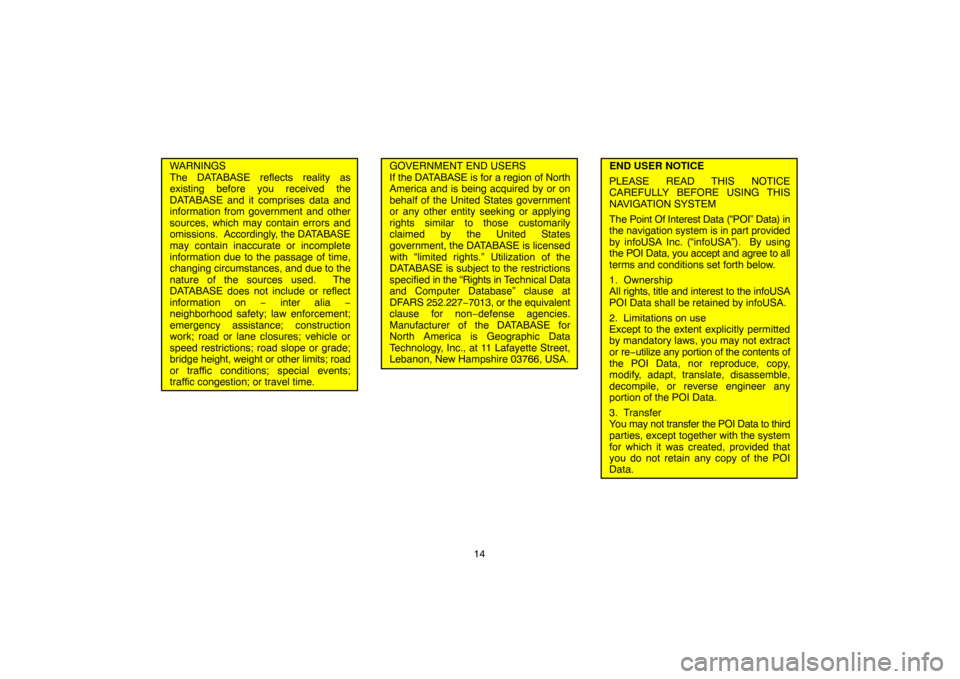lane assist TOYOTA SIENNA 2005 XL20 / 2.G Navigation Manual
[x] Cancel search | Manufacturer: TOYOTA, Model Year: 2005, Model line: SIENNA, Model: TOYOTA SIENNA 2005 XL20 / 2.GPages: 152, PDF Size: 5.15 MB
Page 1 of 152

i
2005 SIENNA Navigation from Sep. ’04 Prod. (OM45419U)
Introduction
Thank you for your purchase of the Navigation System. Please read this manual carefully to ensure proper use. Keep this manual
in your vehicle at all times.
The Navigation System is one of the most technologically advanced vehicle accessories ever developed. The system receives satellite signals
from the Global Positioning System (GPS) operated by the U.S. Department of Defense. Using these signals and other vehicle sensors, the
system indicates your present position and assists in locating a desired destination.
The navigation system is designed to select efficient routes from your present starting location to your destination. The system is designed
to direct you to a destination that is unfamiliar to you in an efficient manner. The system uses the maps of DENSO. The calculated routes
may not be the shortest nor the least traffic congested. Your own personal local knowledge or “short cut” may at times be faster than the calcu-
lated routes.
The navigation system’s database includes about 75 Point of Interest categories to allow you to easily select destinations such as restaurants
and banks. If a destination is not in the database, you can enter the street address or a major intersection close to it and the system will guide
you there. The system will provide both a visual map and audio instructions. The audio instructions will announce the distance remaining
and the direction to turn in approaching a fork or intersection. These voice instructions will help you keep your eyes on the road and are timed
to provide enough time to allow you to maneuver, change lanes or slow down.
Please be aware that all current vehicle navigation systems have certain limitations that may affect their ability to perform properly.
The accuracy of the vehicle’s position depends on the satellite condition, road configuration, vehicle condition or other circumstan-
ces. For more information on the limitations of the system, refer to pages 10 through 12.
Page 24 of 152

14
WARNINGS
The DATABASE reflects reality as
existing before you received the
DATABASE and it comprises data and
information from government and other
sources, which may contain errors and
omissions. Accordingly, the DATABASE
may contain inaccurate or incomplete
information due to the passage of time,
changing circumstances, and due to the
nature of the sources used. The
DATABASE does not include or reflect
information on − inter alia −
neighborhood safety; law enforcement;
emergency assistance; construction
work; road or lane closures; vehicle or
speed restrictions; road slope or grade;
bridge height, weight or other limits; road
or traffic conditions; special events;
traffic congestion; or travel time.GOVERNMENT END USERS
If the DATABASE is for a region of North
America and is being acquired by or on
behalf of the United States government
or any other entity seeking or applying
rights similar to those customarily
claimed by the United States
government, the DATABASE is licensed
with “limited rights.” Utilization of the
DATABASE is subject to the restrictions
specified in the “Rights in Technical Data
and Computer Database” clause at
DFARS 252.227−7013, or the equivalent
clause for non−defense agencies.
Manufacturer of the DATABASE for
North America is Geographic Data
Technology, Inc., at 11 Lafayette Street,
Lebanon, New Hampshire 03766, USA.END USER NOTICE
PLEASE READ THIS NOTICE
CAREFULLY BEFORE USING THIS
NAVIGATION SYSTEM
The Point Of Interest Data (“POI” Data) in
the navigation system is in part provided
by infoUSA Inc. (“infoUSA”). By using
the POI Data, you accept and agree to all
terms and conditions set forth below.
1. Ownership
All rights, title and interest to the infoUSA
POI Data shall be retained by infoUSA.
2. Limitations on use
Except to the extent explicitly permitted
by mandatory laws, you may not extract
or re−utilize any portion of the contents of
the POI Data, nor reproduce, copy,
modify, adapt, translate, disassemble,
decompile, or reverse engineer any
portion of the POI Data.
3. Transfer
You may not transfer the POI Data to third
parties, except together with the system
for which it was created, provided that
you do not retain any copy of the POI
Data.